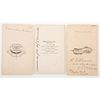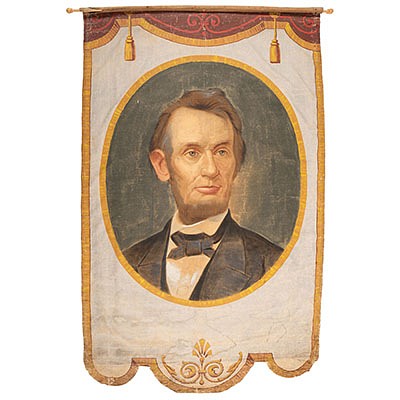[CIVIL WAR]. A group of 3 CDVs of identified US Navy officers, incl. Thomas McKean Buchanan, DOW, G.F. Bemis, and Henry H. Gorringe.
About Seller
6270 Este Ave.
Cincinnati , OH 45232
United States
With offices in Cincinnati, Cleveland and Denver, Cowan’s holds over 40 auctions each year, with annual sales exceeding $16M. We reach buyers around the globe, and take pride in our reputation for integrity, customer service and great results. A full-service house, Cowan’s Auctions specializes in Am...Read more
Two ways to bid:
- Leave a max absentee bid and the platform will bid on your behalf up to your maximum bid during the live auction.
- Bid live during the auction and your bids will be submitted real-time to the auctioneer.
Bid Increments
| Price | Bid Increment |
|---|---|
| $0 | $25 |
| $500 | $50 |
| $1,000 | $100 |
| $2,000 | $250 |
| $5,000 | $500 |
| $10,000 | $1,000 |
| $20,000 | $2,500 |
| $50,000 | $5,000 |
| $100,000 | $10,000 |
About Auction
Jun 25, 2021
The June 25 American Historical Ephemera and Photography Auction features an exciting assemblage of 18th-early 20th century material, including Civil War archives, Early Photography, Western Americana, Autographs and Manuscripts, and more. Cowan's Auctions dawnie@cowans.com
- Lot Description
CDV of officer casually posed beside a column with cap in hand. New Orleans: E. Jacobs & Co., [1860s]. Beneath the portrait is name "Buchanan" in period pencil. (Near excellent, sharp corners.) Thomas McKean Buchanan, Lieut. Commander U.S.N. was appointed an Acting Midshipman, 10/1/51 entering the Naval Academy. With superior marks in his class he graduated as a Midshipman 6/9/55; Passed Midshipman, 4/15/58; Master, 11/4/58; Lieutenant, 7/18/60; Lieutenant Commander, 7/16/62; Died of Wounds, 1/14/63. Admiral Farragut wrote from Pensacola about September, 1862: "Lieutenant Commander McKean Buchanan, with light draft steamers, had been operating successfully in Berwick Bay and Atchafalaya River." And again, from New Orleans, November 14, 1862, to the Secretary of the Navy, he encloses Lieutenant Commander Buchanan's report, saying, "He is commanding the naval forces co-operating with the army in Opelousas, and had already two fights with the enemy's steamers and land forces." On January 14, 1863 Commodore Buchanan (a courtesy rank afforded an officer picked to command a squadron) ascended Bayou Teche on board the gunboat Calhoun. Coming under enemy fire he went forward in an exposed position and was at once targeted by Confederate sharpshooters on the bank. The brave officer was soon struck in the head and dropped dead on the deck. His daring courage and activity while in command of these light draft steamers made his name widely known in newspapers throughout the country. Lieutenant Commander Buchanan died unmarried, and his remains were subsequently sent to his birthplace in Bellefonte, PA. Admiral Farragut, writing home, mentions his death as follows, January 15th: "Yesterday was a sad day for me. I went to see Banks; he handed me a dispatch from the bar, announcing the loss of the Hatteras. When I came on board I received another, telling me of the death of one of my bravest and most dashing officers, Lieutenant Commander Buchanan."
[With:]
CDV featuring period autographed vignette of "G.F. Bemis / AA Paymaster / USS Champion / Res / Hyde Park / Mass." New Orleans: Washburn, [1860s]. (Severe bend at top, otherwise showing just minor wear with strong corners.) A wartime commission, G.F. Bemis became Acting Asst. Paymaster, 9/26/63; Discharged in same rank, 10/25/65. Post war he rejoined the navy and was commissioned Assistant Paymaster 2/27/67; Passed Asst. Paymaster, 7/2/69; Dismissed from service 5/12/75 (reason unknown). USS Champion was a sidewheel tinclad (No. 24) gunboat commissioned April 26, 1863. She served primarily on the Mississippi River undertaking routine patrol duties and also saw service on the Tennessee and Red Rivers during the war transporting troops and supplies including captured cotton, convoy duty, and as a dispatch boat. Champion was decommissioned at Mound City in July 1865 and sold out of service in November.
[With:]
CDV, sharp vignette ink signed beneath portrait, "Henry H. Gorringe" with billet inked on verso along right margin, "Commander of the USS Vindicator." Vicksburg, MS: French &. Co., Successors to D.P. Barr, Army Photographer (Late Barr & Young), Palace of Art, [1860s]. (Near excellent with minor lower edge wear, softening corners.) Henry H. Gorringe was another war commission destined to see service through 1883. He joined at Mate, 7/13/62; Acting Ensign, 10/1/62; Acting Master, 9/26/63; Acting Volunteer Lieutenant, 4/27/64; Acting Volunteer Lieut. Commander, 7/10/65; Lieutenant, 3/12/68; Lieutenant Commander 12/18/68; Resigned 2/21/83. USS Vindicator was a former civilian steamer commissioned as a gunboat in May 1864. During the last year of the war she served in the Yazoo River expedition and engaged in the pursuit of the Confederate cottonclad CSS William H. Webb on the Red River. During that unsuccessful chase fellow officer Acting Master D.P. Slatterly was recorded as having "stoked his boilers to near bursting point." Slatterly later writing, "such was the spirit animating every officer, man, and boy that all seemed to vie with each other in the rapid and intelligent execution of each order." Vindicator was soon thereafter decommissioned in late April 1865 and sold out of service. The biographical Living Officers of the US Navy, 1870, states that Acting Lieutenant Gorringe "was three times promoted for gallantry in battle" and later in his post-war career given command of the sailing sloop USS Portsmouth.
The Richard B. Cohen Civil War Collection Lots 79-98; 116; 138-153; and 266
Cowan's is pleased to offer the third installment of Richard B. Cohen's collection of Civil War Brown Water Navy photography. Richard was known to many in the field as a "disciplined collector who maintained a relatively narrow focus having built an important, perhaps unsurpassed collection in his area of specialization." From cartes de visite to large format photographs, this portion of the collection features a noteworthy selection of images of Brown Water Navy warships, among them, the USS Benton, Choctaw, Lafayette, and Louisville. Many important identified naval officers are also represented, including an exquisite CDV of the promising young officer, Lieutenant Commander William Gwin, who died of wounds aboard the USS Benton following an artillery duel with Confederate forces at Snyder's Bluff, and an exceptionally large war-date photograph of the controversial commander of the USS Pittsburgh, Egbert Thompson.
This auction also features a premiere selection of autographs and manuscripts from Richard's carefully curated collection. Highlights include a letter from Jefferson Davis to his distant cousin, John J. Pettus, Governor of Mississippi, dated a year before secession, conveying intricate plans for securing armaments in preparation for the war; an Abraham Lincoln signed endorsement; a letter from Admiral D.G. Farragut from New Orleans, offering excellent insight into his "political" thinking as well as his dedication to his work; correspondence from Gideon Welles, David Dixon Porter, U.S. Grant, and W.T. Sherman; and a pair of superb letters with highly descriptive accounts of the Battle of the Monitor and Merrimac.
Provenance: The Richard B. Cohen Civil War Collection - Shipping Info
-
SHIPPING & PICKUPS Cowan’s Cincinnati Office offers an in-house, full-service shipping department which is unparalleled in the auction industry. Shipping costs are provided with your finalized invoice 24-48 hours after auction. For furniture and oversized items, we recommend using third-party services. For more information, contact cowansshipping@hindmanauctions.com. NOTE: All pickups and preview are by appointment only. To make an appointment, please call 513-871-1670 or email cincinnati@hindmanauctions.com Buyers are required to pay for all packing, shipping and insurance charges. Overseas duty charges are the responsibility of the successful Bidder. Be aware that for larger and/or valuable items, shipping charges can be substantial. - Shipping charges include insurance for your order while in transit. If you have private insurance we will adjust your charge to include only packing and shipping. - Please allow 14 – 21 days after payment to package and ship your purchase as carefully as possible.
-
- Buyer's Premium



 EUR
EUR CAD
CAD AUD
AUD GBP
GBP MXN
MXN HKD
HKD CNY
CNY MYR
MYR SEK
SEK SGD
SGD CHF
CHF THB
THB![[CIVIL WAR]. A group of 3 CDVs of identified US Navy officers, incl. Thomas McKean Buchanan, DOW, G.F. Bemis, and Henry H. Gorringe.](https://s1.img.bidsquare.com/item/l/8589/8589558.jpeg?t=1LMY24)
![[CIVIL WAR]. A group of 3 CDVs of identified US Navy officers, incl. Thomas McKean Buchanan, DOW, G.F. Bemis, and Henry H. Gorringe.](https://s1.img.bidsquare.com/item/s/8589/8589558.jpeg?t=1LMY24)











